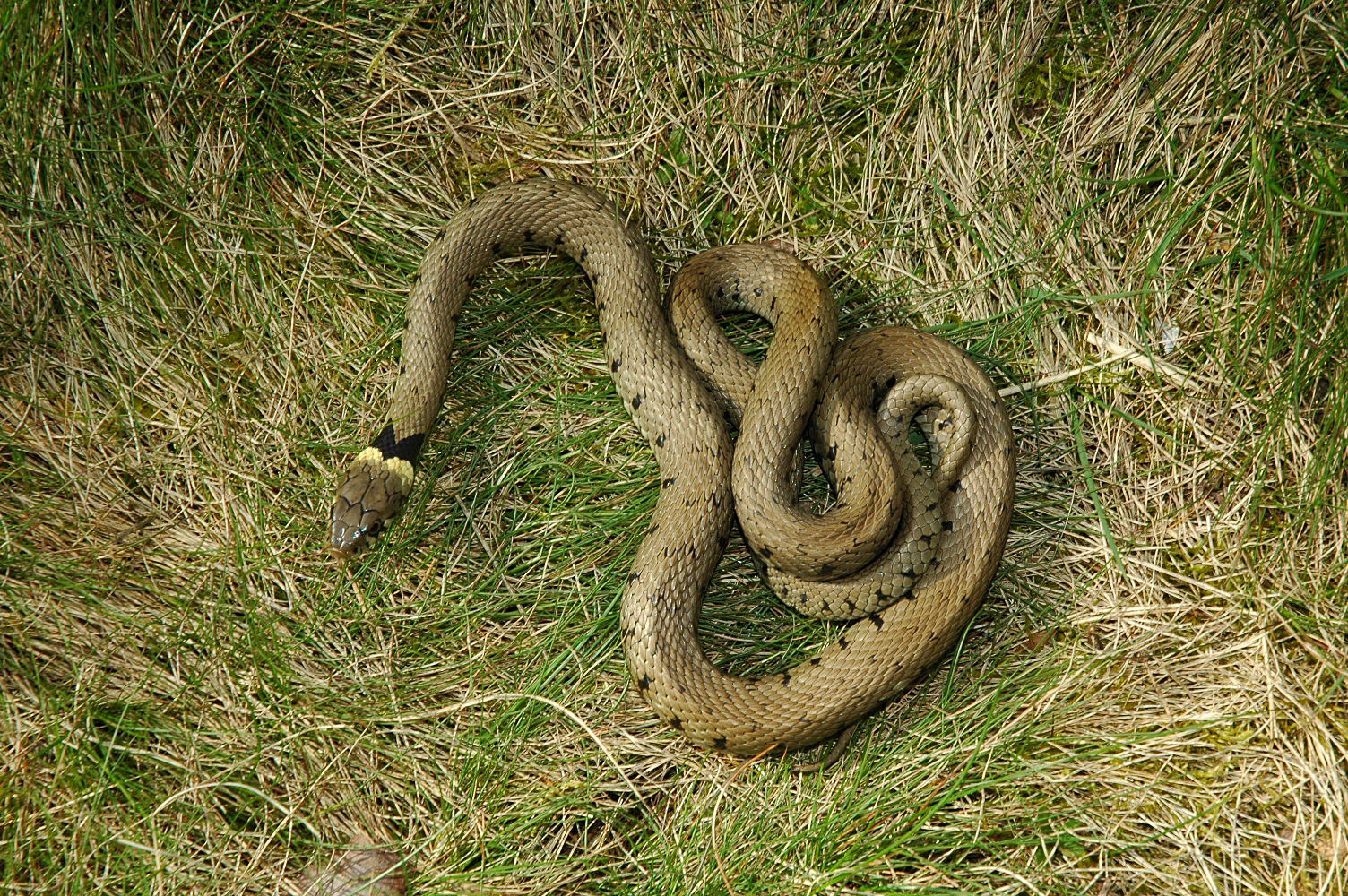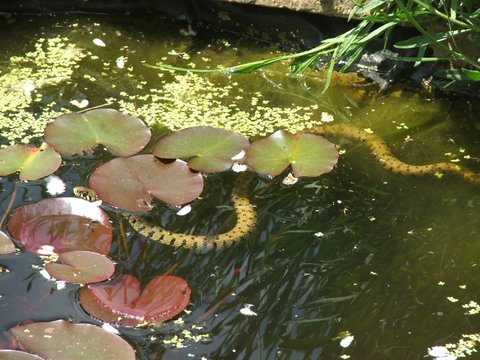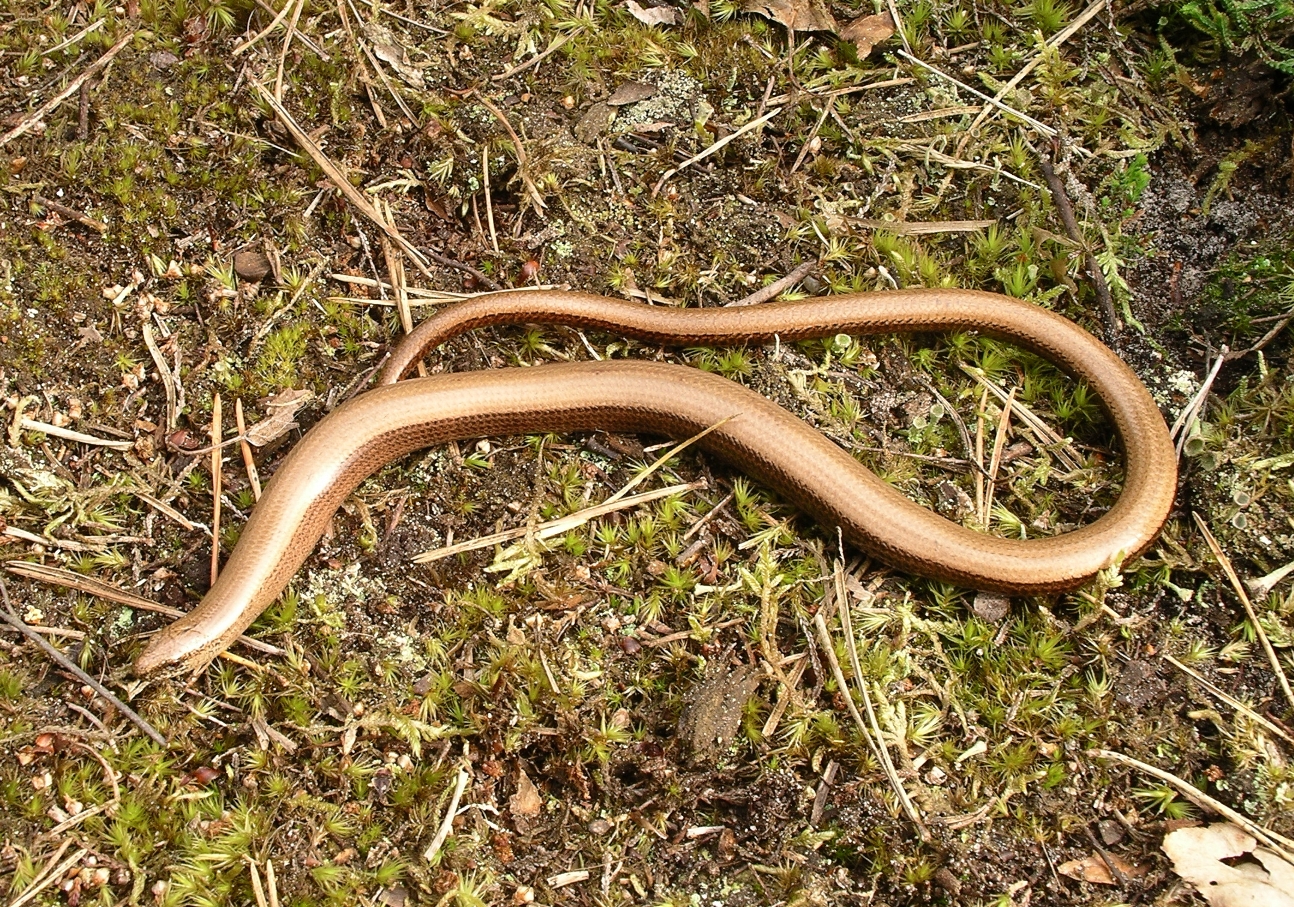Reptiles
John W. Wilkinson and Peter Hill, Amphibian and Reptile Conservation Reviewed by Steve Head
Two species (grass snake and slow worm) of our six native reptiles commonly use gardens, and one other (common lizard) is regularly seen in some. While everyone welcomes hedgehogs, birds and butterflies, some people have mixed or even strongly negative feelings about reptiles. The truth is that the species that may live in your garden are completely harmless and even beneficial for gardeners, but as a species, we humans seem to have an innate fear of snakes - probably for good reason since we evolved in Africa where many snakes are very dangerous.
Reptiles are secretive in gardens, and much harder to spot than amphibians. They are cold-blooded, but attempt to keep their temperature above ambient by behavioural strategies including sunbathing. Reptiles love sources of heat, such as compost heaps, and can also be seen basking in the sun on rocks, bare ground or short grass.
Almost any kind of compost heap will be used by these species but the attractiveness of a heap can be improved by
• choosing a sunny, south-facing spot
• making your heap or bin accessible by using traditional construction (e.g. wooden palettes or slats with easy
access) if you can
• keen composters can have two or more heaps so that there is always one available to which any reptile residents
can be transferred when you want to use the compost
• place an old mat or section of carpet on top of the heap to provide extra cover – and use it to gently view the
reptiles using the heap.
A good way to locate them is to put down small (c1m2) sheets of corrugated iron which give protection, and rapidly warm up in the sun. When you carefully raise the sheet, the reptiles are revealed - until they skitter away.
Grass snakes Natrix helvetica
As of 2017, a genetic study established that the grass snakes found in Britain should be classified as a separate species N. helvetica, previously considered only a sub species (Natrix natrix helvetica) of the European population. It is suggested that the barred grass snake N. helvetica differs from N. natrix in that the body colour is grey rather than olive green, and it lacks the bright yellow collar. The British snakes sampled in the study all classified genetically as N. helvetica, but the colour of many British examples (as below) appear to correspond to that of the nominal N. natrix, so colour seems unreliable to distinguish the two.
Slow worms Anguis fragilis
In evolutionary terms, the slow worm is not a true snake, but a legless lizard which has adopted a similar body plan through convergent evolution. They are blunt-headed, primarily burrowing reptiles which, rather like millipedes, concentrate on the ability to force their way through detritus, rather than fast agile movement. They are found throughout Britain (and have recently been introduced in Ireland) but are more common in the south of England. Slow worms do well in gardens, particularly if they are well vegetated and quiet. They eat slugs, snails, worms and insects, and should be seen as very beneficial to the garden.



Lizards
We have two typical lizards with legs in Britain, the common (or viviparous) and sand lizards. The sand lizard is very scarce and local, found on sandy heaths and duneland in a few locations in England and Wales.
Common lizards Zootoca vivipara are widespread in Britain, and the only reptile found native in Ireland, but are patchy in distribution, avoiding intensive agricultural land, and are not likely to turn up in your garden unless it is next to a larger area of suitable habitat. In the wild they like moorland and woodland margins, but also do well on brownfield sites and railway embankments, probably enjoying the opportunities to bask in sunlight.
They are very variable in colour, with light and dark marks on a grey or brown background. Adults are about 14cm long (including the tail). After mating in spring, females incubate their eggs internally, and give birth to 2.5cm young in midsummer. Common lizards live about 5-6 years and are mature at 2-3. Their main food is insects and spiders.
![Grass snake. Natrix helvetica By Benny Trapp (Own work) [CC BY-SA 4.0 (https://creativecommons.org/licenses/by-sa/4.0)], via Wikimedia Commons](images/BennyTrapp_Natrix_helvetica.jpg)
These handsome and harmless snakes grow up to 75cm long, and are widely distributed in the southern half of England and Wales, but only found rarely in the south of Scotland. They are olive-green to brown to grey in colour, with black marks along their flanks, but only lightly on the back. They have a grey-white or yellow patch just behind the head on each side of their "neck", and typical N. natrix are sometimes referred to as ringed snakes.
The scientific name of the grass snake means "swimmer", and they are most commonly spotted near or in ponds, where they hunt for frogs and (rarely) small fish. They are the only snake you are likely to see in your garden, and in practice they can be quite secretive and fast moving, so you may not realise you have one hanging around your pond. When they are disturbed they can move very fast. Although not venomous, grass snakes when distressed can, in a skunk-like fashion, discharge highly offensive secretions from their anal glands
Grass snakes lay 20-40 eggs, and like the warmth of compost heaps and piles of grass cuttings to incubate the eggs. They can live as long as 18 years, and are generally mature at about 3, but many young grass snakes do not survive their first year.
Adder Vipera berus for information only
An adder can only be confused with a grass snake if you aren't prepared to take a cautious closer look. They are shorter (about 55cm) than adult grass snakes, and rather thicker. They lack the white marks on the "neck", but have a prominent zig-zag line of dark brown or reddish lozenges all down the back from head to tail. If you can see the head clearly, it is noticeably wider than the neck. Adders are much less common than grass snakes, and very rarely seen in gardens unless they are next to a spot of prime habitat. Typically adders like free-draining sand and chalk soils, and rarely turn up on damp or clay soils.
Top left: British grass snake, presumably Natrix helvetica with colour matching Natrix natrix. It is olive-green in overall colour, and has a prominent yellow collar in front of the two black areas behind the head.
Left: This shows a European barred grass snake N. helvetica individual which is a greyer colour, and lacks the yellow collar, which is replaced by a light grey band.
Top right: Both species love water and are excellent swimmers. This Oxfordshire snake again shows colour more typical of N. natrix.
![Adder Vipera berus Photo: By Huhu Uet (Own work) [GFDL (http://www.gnu.org/copyleft/fdl.html) or CC BY-SA 3.0 (https://creativecommons.org/licenses/by-sa/3.0)], via Wikimedia Commons](images/Adder and grass snake.jpg)
Large adder and small grass snake nicely posed for comparison.
The adder's stout frame, wide head and prominent markings down the back are very clear.
.jpg)
Common or viviparous lizard on Oxfordshire nature reserve.
![Photo: By DuncanFoto (Own work) [CC BY-SA 4.0 (https://creativecommons.org/licenses/by-sa/4.0)], via Wikimedia Commons](images/slow worm head.jpg)
Adult slow worm Close up view of slow worm's face and tongue
Adult slow worms are shiny-skinned, with shades of brown, copper or grey, and some have darker sides and a thin dark dorsal line.The head is narow, with no definable "neck" separating it from the body. The tail is rather blunt, particularly in individuals which (like other lizards) have sacrificed and shed their tail to escape a predator. This process, called autotomy and can easily be caused by careless handling. The tail can regrow, but only partially, so please avoid handling slow worms if you can.
Slow worms grow up to half a metre in length, and, perhaps because of their cryptic behaviour, have been found to live up to 30 years in the wild. Like the common lizard, they give birth to live young, and find warm and food-rich compost heaps particularly good places to rear them.
Escaped pet reptiles
Amphibian and Reptile Conservation (ARC) receive increasing calls from the public about snakes in urban gardens. In many cases these turn out to be escaped pythons, king snakes, corn snakes and boas. These can look impressive, but are all harmless, and will not survive a normal British winter out of doors. It is best to report such escapees to the RSPCA or animal rescue centre. ARC have a useful web page with illustrations to help identify common escapees, and the British Herpetological Society manage a hot-line for reptile rescuers.
Links:
Natural England leaflet Reptiles in your garden
Reptiles
Two species of our six native reptiles (grass snake and slow worm) commonly use gardens, and one other (common lizard) is regularly seen in some. While everyone welcomes hedgehogs, birds and butterflies, some people have mixed or even strongly negative feelings about reptiles. The truth is that the species that may live in your garden are completely harmless and even beneficial for gardeners, but as a species, we humans seem to have an innate fear of snakes - probably for good reason since we evolved in Africa where many snakes are very dangerous.
Reptiles are secretive in gardens, and much harder to spot than amphibians. They are cold-blooded, but attempt to keep their temperature above ambient by behavioural strategies including sunbathing. Reptiles love sources of heat, such as compost heaps, and can also be seen basking in the sun on rocks, bare ground or short grass.
Almost any kind of compost heap will be used by these species but the attractiveness of a heap can be improved by
• choosing a sunny, south-facing spot
• making your heap or bin accessible by using traditional construction (e.g. wooden palettes or slats with easy
access) if you can
• keen composters can have two or more heaps so that there is always one available to which any reptile residents
can be transferred when you want to use the compost
• place an old mat or section of carpet on top of the heap to provide extra cover – and use it to gently view the
reptiles using the heap.
A good way to locate them is to put down small (c1m2) sheets of corrugated iron which give protection, and rapidly warm up in the sun. When you carefully raise the sheet, the reptiles are revealed - until they skitter away.
All native British reptiles are protected in Schedule 5 of the Wildlife and Countryside Act of 1981
Grass snakes Natrix helvetica
As of 2017, a genetic study established that the grass snakes found in Britain should be classified as a separate species N. helvetica, previously considered only a sub species (Natrix natrix helvetica) of the European population. It is suggested that the barred grass snake N. helvetica differs from N. natrix in that the body colour is grey rather than olive green, and it lacks the bright yellow collar. The British snakes sampled in the study all classified genetically as N. helvetica, but the colour of many British examples (as below) appear to correspond to that of the nominal N. natrix, so colour seems unreliable to distinguish the two.

![Grass snake. Natrix helvetica By Benny Trapp (Own work) [CC BY-SA 4.0 (https://creativecommons.org/licenses/by-sa/4.0)], via Wikimedia Commons](images/BennyTrapp_Natrix_helvetica.jpg)

British grass snake, presumably Natrix helvetica but with colour matching Natrix natrix. It is olive -green in overall colour, and has a prominent yellow collar in front of the two black areas behind the head.
Both species love water and are excellent swimmers. This Oxfordshire snake again shows colour more typical of N. natrix.
Left: This shows a European barred grass snake N. helvetica individual which is a greyer colour, and lacks the yellow collar, which is replaced by a light grey band.
These handsome and harmless snakes grow up to 75cm long, and are widely distributed in the southern half of England and Wales, but only found rarely in the south of Scotland. They are olive-green to brown to grey in colour, with black marks along their flanks, but only lightly on the back. They have a grey-white or yellow patch just behind the head on each side of their "neck", and typical N. natrix are sometimes referred to as ringed snakes.
The scientific name of the grass snake means "swimmer", and they are most commonly spotted near or in ponds, where they hunt for frogs and (rarely) small fish. They are the only snake you are likely to see in your garden, and in practice they can be quite secretive and fast moving, so you may not realise you have one hanging around your pond. When they are disturbed they can move very fast. Although not venomous, grass snakes when distressed can, in a skunk-like fashion, discharge highly offensive secretions from their anal glands
Grass snakes lay 20-40 eggs, and like the warmth of compost heaps and piles of grass cuttings to incubate the eggs. They can live as long as 18 years, and are generally mature at about 3, but many young grass snakes do not survive their first year.
Adder Vipera berus for information only
An adder can only be confused with a grass snake if you aren't prepared to take a cautious closer look. They are shorter (about 55cm) than adult grass snakes, and rather thicker. They lack the white marks on the "neck", but have a prominent zig-zag line of dark brown or reddish lozenges all down the back from head to tail. If you can see the head clearly, it is noticeably wider than the neck. Adders are much less common than grass snakes, and very rarely seen in gardens unless they are next to a spot of prime habitat. Typically adders like free-draining sand and chalk soils, and rarely turn up on damp or clay soils.
![Adder Vipera berus Photo: By Huhu Uet (Own work) [GFDL (http://www.gnu.org/copyleft/fdl.html) or CC BY-SA 3.0 (https://creativecommons.org/licenses/by-sa/3.0)], via Wikimedia Commons](images/Adder and grass snake.jpg)
Large adder and small grass snake nicely posed for comparison.
The adder's stout frame, wide head and prominent markings down the back are very clear.
Lizards
We have two typical lizards with legs in Britain, the common (or viviparous) and sand lizards. The sand lizard is very scarce and local, found on sandy heaths and duneland in a few locations in England and Wales.
Common lizards Zootoca vivipara are widespread in Britain, and the only reptile found native in Ireland, but are patchy in distribution, avoiding intensive agricultural land, and are not likely to turn up in your garden unless it is next to a larger area of suitable habitat. In the wild they like moorland and woodland margins, but also do well on brownfield sites and railway embankments, probably enjoying the opportunities to bask in sunlight.
They are very variable in colour, with light and dark marks on a grey or brown background. Adults are about 14cm long (including the tail). After mating in spring, females incubate their eggs internally, and give birth to 2.5cm young in midsummer. Common lizards live about 5-6 years and are mature at 2-3. Their main food is insects and spiders.
.jpg)

Common or viviparous lizard on Oxfordshire nature reserve.
Slow worms Anguis fragilis
In evolutionary terms, the slow worm is not a true snake, but a legless lizard which has adopted a similar body plan through convergent evolution. They are blunt-headed, primarily burrowing reptiles which, rather like millipedes, concentrate on the ability to force their way through detritus, rather than fast agile movement. They are found throughout Britain (and have recently been introduced in Ireland) but are more common in the south of England. Slow worms do well in gardens, particularly if they are well vegetated and quiet. They eat slugs, snails, worms and insects, and should be seen as very beneficial to the garden.
Adult slow worms are shiny-skinned, with shades of brown, copper or grey, and some have darker sides and a thin dark dorsal line.The head is narow, with no definable "neck" separating it from the body. The tail is rather blunt, particularly in individuals which (like other lizards) have sacrificed and shed their tail to escape a predator. This process, called autotomy and can easily be caused by careless handling. The tail can regrow, but only partially, so please avoid handling slow worms if you can.
Slow worms grow up to half a metre in length, and, perhaps because of their cryptic behaviour, have been found to live up to 30 years in the wild. Like the common lizard, they give birth to live young, and find warm and food-rich compost heaps particularly good places to rear them.
Escaped pet reptiles
Amphibian and Reptile Conservation (ARC) receive increasing calls from the public about snakes in urban gardens. In many cases these turn out to be escaped pythons, king snakes, corn snakes and boas. These can look impressive, but are all harmless, and will not survive a normal British winter out of doors. It is best to report such escapees to the RSPCA or animal rescue centre. ARC have a useful web page with illustrations to help identify common escapees, and the British Herpetological Society manage a hot-line for reptile rescuers.
Links:
Natural England leaflet Reptiles in your garden
Page drafted by John W. Wilkinson and Peter Hill, Amphibian and Reptile Conservation Reviewed and edited by Steve Head
![Slow worm Anguis fragilis Photo: By DuncanFoto (Own work) [CC BY-SA 4.0 (https://creativecommons.org/licenses/by-sa/4.0)], via Wikimedia Commons](images/slow worm head.jpg)
Garden Wildlife
Garden Wildlife


























